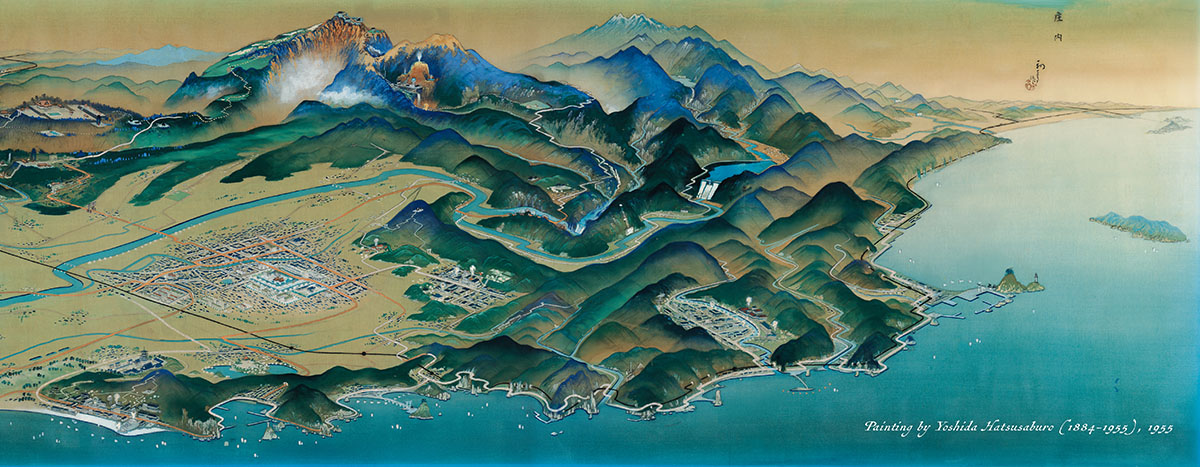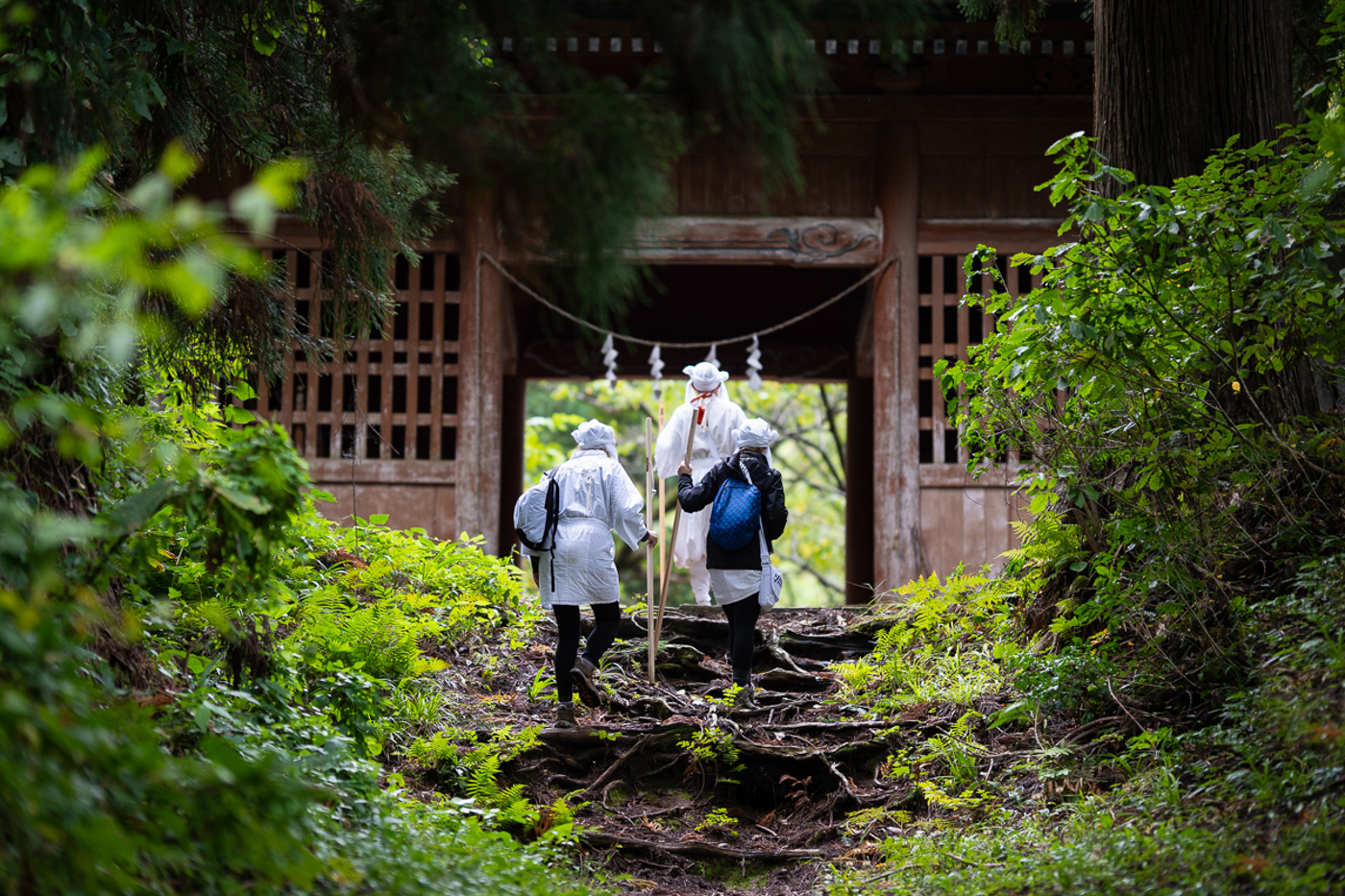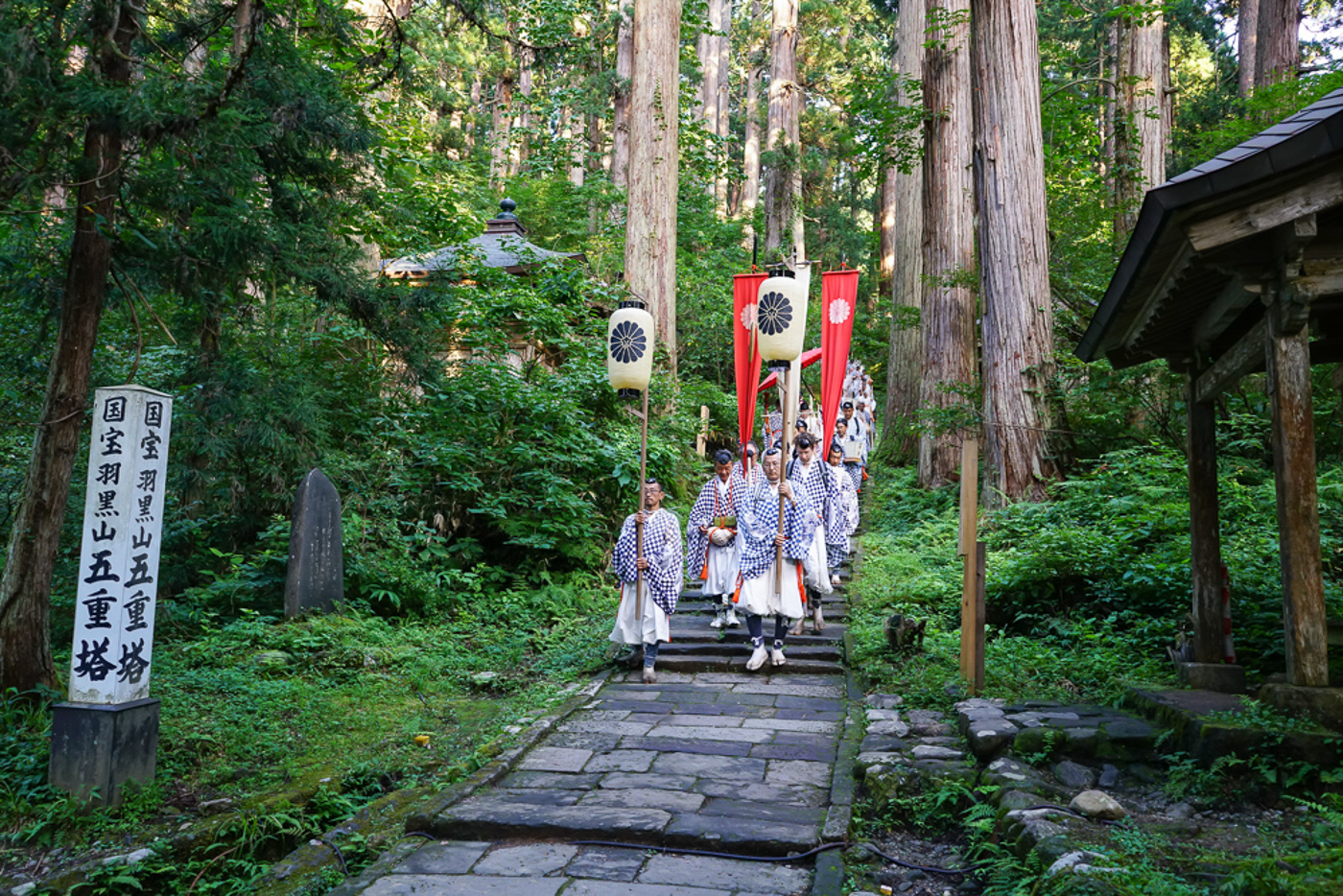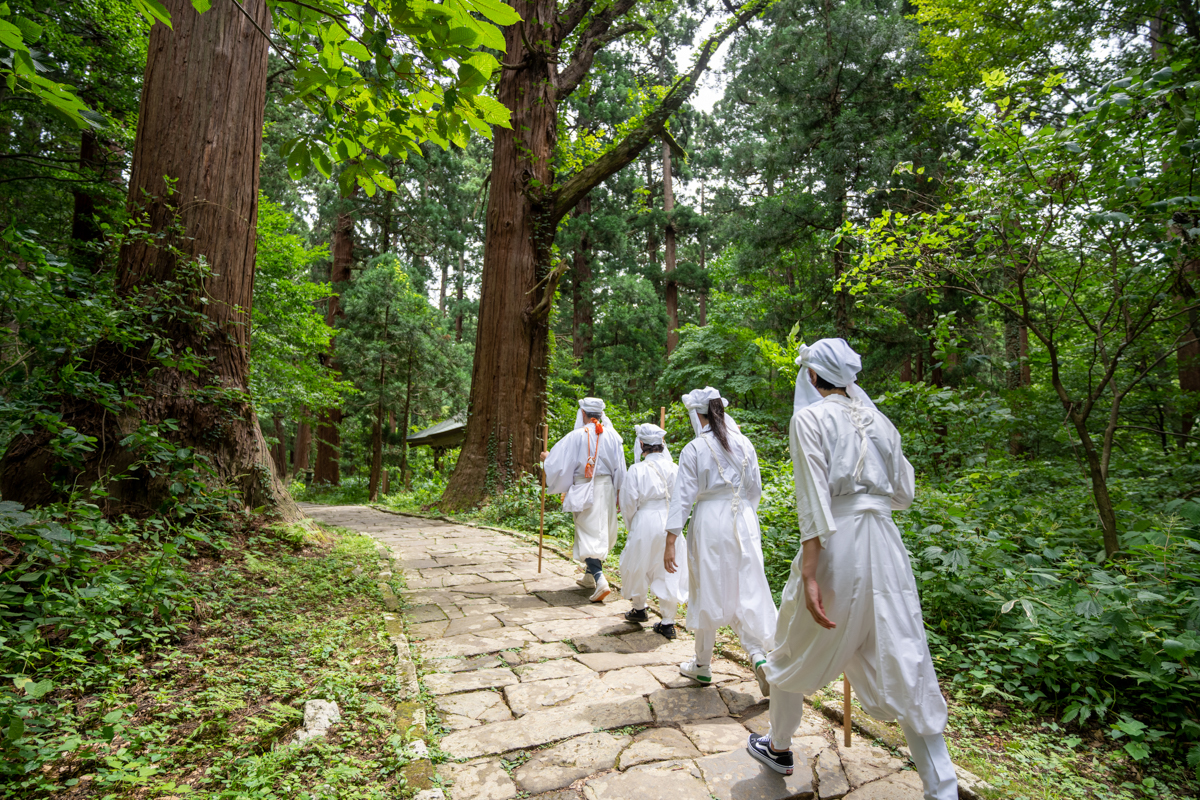
The Three Sacred Mountains of Dewa
The Dewa Sanzan (出羽三山), or The Three Sacred Mountains of Dewa, is the collective name given to three sacred mountains in Yamagata Prefecture: Mount Haguro, Mount Gassan, and Mount Yudono. It has been a pilgrimage site for religious practitioners of Shugendo and home to a transformative journey known as the journey of rebirth for more than 1400 years. Shugendo 修験道 (“the Way of the Harsh Training”) is derived from esoteric Buddhist practices; it includes principles from both the Shinto religion and Taoism and is strongly linked to Japan’s original spirituality, centering on the worship of mountains. The practitioners of Shugendo are called Yamabushi 山伏 (“those who retreat in the mountains”).
These mountains make up one of the Three Main Sites of Shugendo in Japan (日本三大修験道), designated sacred in 593 by the legendary Prince Hachiko, and were central to mountain-worshipping religious practices in the Tohoku region. In addition, the religious tensions between Mt. Yudono and Mt. Haguro led to the emergence of the Sokushinbutsu mummies phenomenon in the Shingon Buddhist temples of Mt. Yudono. Sokushinbutsu are mummies of Shingon Buddhist monks who committed themselves to arduous practices in order to mummify their own bodies. This was done in an effort to become Buddhas themselves. The separation between Shinto and Buddhism—ordered by the Meiji Government in 1868—led to multiple transformations within Dewa Sanzan’s Shugendo practices and architecture.
Despite these transformations, Dewa Sanzan’s practice of Shugendo has continued for the past 1400 years. Even today, you can interact with and attend Yamabushi rites performed by Yamabushi priests.

The history of Shugendo and Yamabushi
To define what the philosophy of the Dewa Sanzan pilgrimage represents, we first need to define what Shugendo is.
Shugendo is above all the concretization of ancient Japanese practices of mountain worship (sangaku shinkô 山岳信仰) which are impossible to date. More ancient than all known religions in Japan and having appeared long before writing came into Japan, mountain worship has been the core of Japanese folklore for many millennia, shaping the rituals and beliefs that later formed into the Shinto religion. Mountains carry a dual role: they are life-givers, as snow melting in the spring releases mineral-rich waters to nourish crops; yet they are also revered as the eternal resting place of ancestors’ souls and feared for their wild and perilous landscapes. In the Dewa Sanzan area, the highest of the three mountains, Mt. Gassan, features sweeping views of the Shonai plain and its fields. Even today, the abundance of snow on Mt. Gassan is seen as a sign of a prosperous rice harvest to come, while a lack of snow brings concerns of scarcity, reflecting how the mountain’s snowy peaks are perceived as blessings from the gods. Hence, at its origins, mountain worship was a cult cherished by the farming population, to pay respects to water and the life that was possible thanks to it.
Unlike most major religions, in both Shinto and traditional mountain worship, gods are not visible entities and do not manifest before people. When commoners sought connection with these gods, they had to receive them in their bodies. This is the role of the Yamabushi, who train in the mountains to become “vessels” for divine presence, transmitting sacred messages and wisdom to the surrounding community.
Yamabushi attain this worthiness through rigorous training, shaped by shamanistic practices from Siberia that arrived in Japan via the Korean Peninsula thousands of years ago. These practices centered on hardship and endurance, taking place from autumn through winter, so that in spring, the Yamabushi would reveal their spiritual power as the mountains released their sacred waters to the plains. Taoism also played a key role in shaping Shugendo, bringing with it concepts of immortality, purification through diet (removal of “holy grains”), and a distinctive walking style (uho 禹歩) used by lead Yamabushi on mountain trails, notably during the Aki no Mine Iri (秋の峰入り) retreat.
Apart from shamanism and Taoism, Buddhism also played a big part in the creation of Shugendo. In Indian Buddhism, monks retreat during the rainy season in summer (geango 夏安居), a period during which they recite sutras and make flower offerings (from around April 16 to July 15). This tradition also came to Japan (hence why Japanese celebrate obon お盆 –the return of the ancestors’ souls to the realm of the Dead on July 15). This tradition of retreating in the mountain and dedicating rites to the souls of the dead fused with the previous traditions to merge into the Yamabushi tradition.
In short, Yamabushi are custodians of Japan’s ancient spiritual practices predating the 7th century, offering guidance to those in the plains below. They serve as “mediums” for divine messages, healers with extensive knowledge of medicinal plants, shamans performing rituals to ward off malevolent forces, and spiritual guides leading souls to the afterlife.
Sources: 宮家準、「修験道の歴史と峰入り」、p5-10 in 峰入—修験道の本質を求めて
The origin of Dewa Sanzan’s retreats

Until the late Muromachi Period (1336–1583), the Dewa Sanzan pilgrimage traditionally encompassed Mt. Haguro, Mt. Gassan, and Mt. Hayama, with each mountain symbolizing a bodhisattva. Mt. Haguro was associated with Avalokiteshvara (Kanzeon Bosatsu 観世音菩薩), Mt. Gassan with Amithaba (Amida Nyorai 阿弥陀如来), and Mt. Hayama with Bhaisajyaguru (Yakushi Nyorai 薬師如来). For geographical reasons, Mt. Yudono replaced Mt. Hayama at the beginning of the 17th century and its revered Buddha, Vairocana Buddha (Dainichi nyorai 如来), became the third bodhisattva worshipped in the Dewa Sanzan Buddhist practice. Through mountain retreats, Yamabushi masters and their disciples aspire to encounter these Buddhist deities, drawing closer to spiritual enlightenment.
In the past, Mt. Haguro’s Yamabushi would conduct four retreats each year, one for each season. The longest was the summer retreat (ichige kushun 一夏九旬), a rigorous 90-day practice primarily within Mt. Gassan, focusing on self-purification. Today, however, most practitioners attend only the Autumn Peak Retreat (Aki no Mine Iri 秋の峰入り), held at the end of August.
This is now the only official Yamabushi training open to participation by practitioners and is overseen by both the Dewa Sanzan Shrine, for the Shinto procession, and Shozen’in Temple, for the Haguro Shugen Buddhist tradition. Originally lasting 75 days—reflecting the symbolic 275-day human gestation period—the Autumn Peak Retreat has been shortened to seven days in the modern Shinto tradition and nine in the modern Haguro Shugen Buddhist practice.
The Autumn Peak Retreat is a rigorous program that is open to both Japanese and international participants. Know, however, that this training requires great commitment with many expectations and requirements for participants to follow. You may contact us for more information.
Travelers may find Yamabushi experiences led by local tour companies to be far more approachable. You may see these in the Plan Your Trip section of this website.
The winter retreat is still practiced, but only two specially selected Yamabushi (the “ohijiri” お聖) can take part. It lasts 100 days, concluding at the Shoreisai Festival on December 31. The Shoreisai Festival is the most important ceremony of the year. The two chosen Yamabushi display the divine force they have gathered during their retreat to protect the people and fields from diseases and evil forces.
Throughout these retreats, practitioners endure hunger, cold, fatigue, and physical hardship. Aware of these challenges, they accept the possibility of death before embarking on training. This understanding is symbolized by the white funeral robes (shiroshozoku 白装束) they wear, representing both readiness to “die” and to be reborn as their enlightened selves. Additionally, this traditional attire served a practical purpose: in the event of a disciple’s death during training, they would already be dressed for funerary rites.
Sources: 戸川安章、「羽黒修験の峰入り」、p105-112 in 峰入—修験道の本質を求めて
Yamabushi Training and Experiences on the Dewa Sanzan

Anyone can undertake the transformative journey of the Dewa Sanzan pilgrimage without formal recognition as a Yamabushi. You may take part in your own self-guided experience or a guided program together with the Yamabushi.
We believe that simply walking these sacred trails offers a path to inner change. The pilgrimage requires visiting each of the three mountains: Mt. Haguro, representing the present; Mt. Gassan, symbolizing the past; and Mt. Yudono, embodying the future.
This complete journey to all three of the mountains can only be done during Mt. Gassan’s official hiking season, from July 1 to September 15. While Mt. Haguro is accessible year-round, its stone stairway is snow-covered from late December to mid-March, posing a challenge for less-experienced hikers. Mt. Yudono can be visited from June 1 to November 3. For safety reasons, we strongly advise against visiting Mt. Gassan or Mt. Yudono outside of the official season due to the risks associated with snowfall and other extreme weather conditions.
Yamabushi Training

For those interested in participating in the Autumn Peak Retreat—the only official Yamabushi training open to the public—please submit a contact request. These inquiries must be forwarded to the Dewa Sanzan Shrine or Shozen’in Temple, which may take time to process. Acceptance into the program is not guaranteed, as a selection process determines eligibility.
The Autumn Peak Retreat is the only official Yamabushi training program. Completing this intensive seven-day journey in the mountains is the only way for members of the general public to become recognized as Yamabushi by the Dewa Sanzan Shrine.
Yamabushi Experiences

Aside from the Yamabushi training during the Autumn Peak Retreat, there are many Yamabushi experiences on the Dewa Sanzan. Visitors can request a Yamabushi to guide them on these mountains and even take part in a number of rituals together. Experiences range from guided hikes up Mt. Haguro, special shojin ryori culinary experiences, to multi-day programs. These experiences are arranged by a number of local operators in Yamagata and around Japan. They are made in collaboration with shukubo lodges, Yamabushi, and the Dewa Sanzan Shrine. You may access these on our experiences page here.

